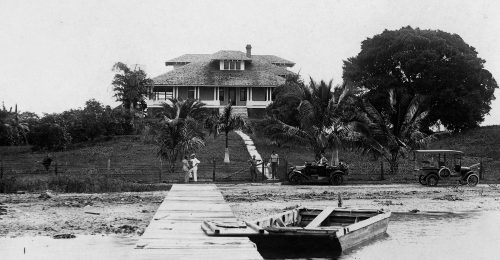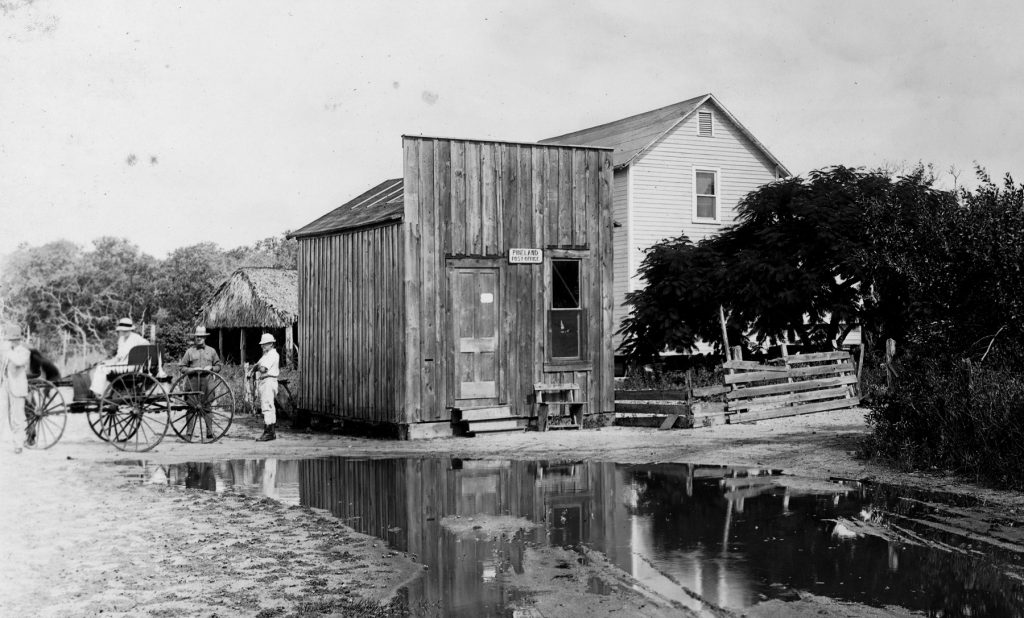At the beginning of the twentieth century only three dozen people lived on Pine Island. The main land use was agriculture, predominantly citrus groves and vegetable gardens.

The Pineland archaeological site — today’s Randell Research Center — remained much as it had appeared when the Calusa Indians were forced to abandon it in 1710. By 1900, gardens had been planted in the low areas, some muck had been dug for fertilizer, and wagon roads meandered between the great mounds.
In 1900, the Glover family sold 19 acres to Henry and Minta Martin. This property probably included some, if not all, of the Brown’s Mound Complex. Minta Martin established the “Pineland” name and its first post office in 1902. As early as 1899, Harro Harrsen began to acquire properties that would ultimately include several of the mounds. Harrsen’s later subdivision of the elevated Brown’s Mound and Randell Mound parcels would establish the configuration for subsequent home construction.
Thomas Stafford became the postmaster in 1905. Stafford (1841-1910), father of Minta Martin, had moved to Pine Island in 1901, having lost his groves in Citrus County due to the great freeze of 1895. He purchased about 19 acres from Elizabeth Glover for one hundred dollars. Containing part of the Pineland site, this property was described as having “ten acres or more of tillable land.”
The year 1911 witnessed the arrival of the Frank and Mary Adams family from Fayette County, Pennsylvania. They farmed, planted groves, and built a large home, which still stands today on a sand and shell mound adjacent to the Pine Island Canal. According to Elaine Jordan, in the 1920s Frank Adams and John Smith built a sawmill at what is now the corner of Pineland Road and Robert Road.
Until 1917, the Pineland post office was located in a small building on Mound 5, across from where the Tarpon Lodge driveway is located today. At the time, only a wagon road existed, and we assume the post office was adjacent to that road. It was surely no coincidence that the post office was moved off of Mound 5 in 1917. According to the recollections of Ted Smith, in that year a new road winding around the mounds (today’s Waterfront Drive) was completed.
The post office remained along this shore-line road until 1925, when a storm washed it away. The postmaster at the time was Ruby Vance Gill, who in 1922 at age 35 had come to Pineland with her husband Percy. They had bought several acres of orange groves and built a two-story house adjacent to Pineland Road. Ruby Gill built a new post office next to her home, where it would be more protected by the mangrove forest that shielded the Gill property.
In the photo below, we see the first version of the post office operated by Ruby Gill. It was located immediately south of the Gill home, which can be seen to the right. The post office building is reminiscent of Florence Hiltbrand’s description, published by Elaine Jordan: “It looked like it had been built for a movie set; you could see the daylight all the way through it.” However, it is unclear whether she was describing the post office pictured here, or the one that had been lost in the 1925 hurricane. The year of construction of the current Pineland post office building is unknown. It is now located next door and west of the Gill house. Ruby Gill was postmaster from 1925 until 1957 (see Friends newsletter, June 2009).

R. D. Wainwright, who visited Pineland in 1917, describes today’s Randell Mound as a large, water- front shell mound, 25 feet high, with a “large residence” on it. According to Ted Smith, the large house was built for Harro Harrsen. It was probably during this building episode that the western (waterfront) side of the mound acquired its terrace. The terracing of the mound is clearly visible in the first photo.
Ted Smith was born in 1910 and grew up at Pineland. He stated that around 1916-1917, substantial parts of several mounds were taken down and used to lay a “base” for Pineland’s local road from the Pineland post office all the way around the waterfront and back east to the old Spicer place where it meets Bokeelia Road. The photograph shown on page 2 dates to about 1917- 1925, not long after the partial removal of these mounds for road fill. The fill would have been mostly whelk and conch shells, and Smith said that the pointed columellas of the shells punctured automobile tires until additional sediment was placed on top. The shell was hauled by wagons pulled by two mules, and it was necessary for the mules to wear special boots to protect their feet from the shells.
Harro Harrsen is the landowner most likely responsible for removing Mounds 3 and 4 and part of Mound 1 of the Randell Mound complex for road-building material. Prior to Harrsen, owners were mostly of the absentee type. By 1909, Harrsen owned much of Pineland, having either bought or inherited property from his father Ferdinan in 1899. Additionally, in 1902 and 1909 he bought property from the Martins. He subdivided and sold most of his properties in 1921 and 1922 and sold his remaining one, presumably Randell Mound 1, in 1930. So, the likely time frame for the road-building is consistent with his ownership. In addition, Harrsen’s good friend Harry Stringfellow is credited for building Stringfellow Road, along with Harrsen’s house on Mound 1. It stands to reason that Stringfellow and Harrsen were involved in building Pineland Road, Waterfront Drive, and Caloosa Drive in the late teens and early twenties.
To be continued in the next issue: Part 2: Recent History of the Pineland Community
This article was taken from the Friends of the Randell Research Center Newsletter Vol 8, No. 3. June 2009.